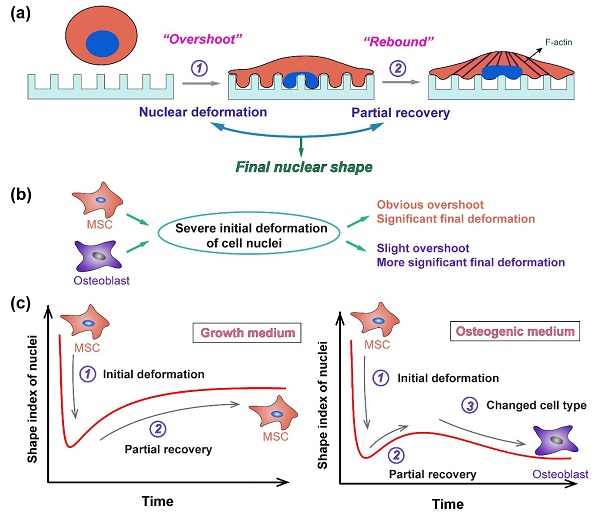 +565 975 658
+565 975 658
 info@premiumcoding.com
info@premiumcoding.com
 Monday - Friday, 8.00 - 20.00
Monday - Friday, 8.00 - 20.00
Cell-material interface affords a dynamic and complex microenvironment of cells. A cell could sense its external material features, convert mechanical, biophysical and biochemical cues into intracellular signals, and finally lead to a changed cell function and gene expression. A subcellular-level study of nuclear shape is helpful for comprehensive understanding of cell-material interactions, which might shed new insight onto the development of biomaterials, tissue engineering, regenerative medicine and biomechanics.
The overshoot phenomenon of nuclear deformation on PLGA micropillar array was found by Ding’s group. Severe self-deformation of cell nuclei happened at initial stage, then the deformed nuclei partially recovered. The results of treatment by cytoskeleton inhibitor illustrated that actin cytoskeleton took part in providing the driving force of nuclear recovery. In observations of the nuclear deformations of mesenchymal stem cells (MSCs), differentiated cells and differentiating cells, they found non-monotonic deformation in all the cases; yet the kinetic process exhibited cell-type dependence with one overshoot for MSCs and differentiated cells, and two overshoots for the differentiating cells.

The paper has been published in an ACS journal with Ms. Xiangnan Liu, a PhD student supervised by Professor Jiandong DING as the first author. See details: Xiangnan Liu, Ruili Liu, Yexin Gu, and Jiandong Ding*, Nonmonotonic Self-Deformation of Cell Nuclei on Topological Surfaces with Micropillar Array, ACS Applied Materials & Interfaces, 9, 18521-18530 (2017).
Link:http://pubs.acs.org/doi/abs/10.1021/acsami.7b04027
Get to know us better now!

Wechat:FDUMMers
Search!
Search across our website
Revenant @ 2018 by fudan | All Rights Reserved
Powered by Weicheng

